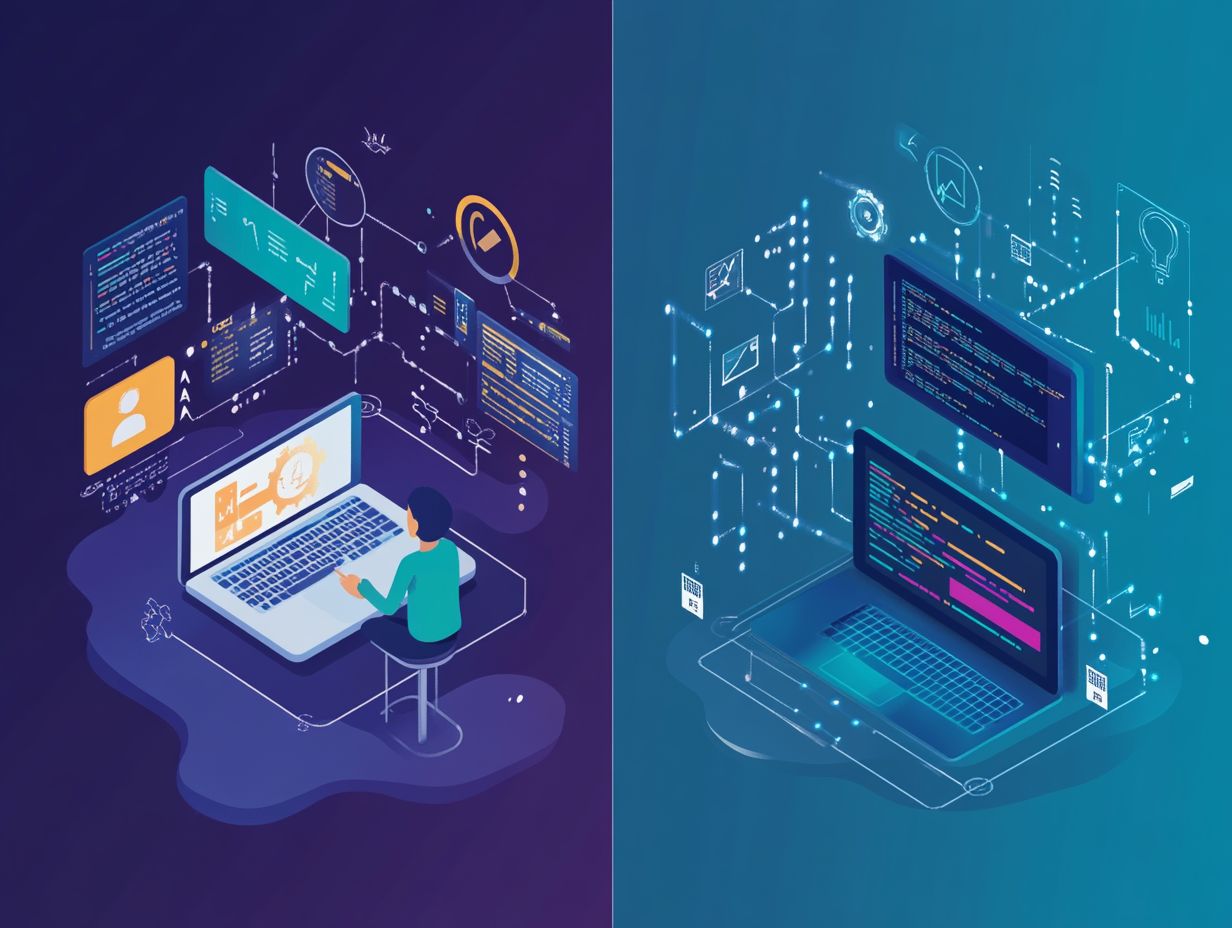SaaS vs. PaaS: What’s the Difference?
In today s digital landscape, understanding the difference between Software as a Service (SaaS) and Platform as a Service (PaaS) is crucial for optimizing your business operations.
Each model has unique functionalities, cost structures, and scalability options, catering to different needs. This piece will clarify the core differences and examine their applications in various industries.
This piece also explores future trends shaping the SaaS and PaaS sectors. Discover how these technologies can revolutionize your business strategy!
Contents
Key Takeaways:

Understanding the Basics
Grasping the fundamentals of cloud computing is essential for businesses aiming to leverage artificial intelligence and cloud services. This helps elevate operations, streamline processes, and secure data effectively.
Cloud computing includes Software as a Service (SaaS), Platform as a Service (PaaS), and Infrastructure as a Service (IaaS). Each model is designed to meet specific business needs and offers different customization options.
When setting up cloud services, weigh factors like vendor lock-in, which means being stuck with one provider, and the reliability of third-party vendors. Consider how application deployment impacts your overall infrastructure.
Key Differences Between SaaS and PaaS
Knowing the key differences between SaaS and traditional software is vital for optimizing your cloud computing strategy.
SaaS delivers complete software solutions over the internet, allowing easy access to applications through a web browser.
PaaS provides a platform for developers to build and deploy applications without worrying about managing the underlying infrastructure. Understanding these differences helps you make informed decisions that align with your specific business needs.
Functionality and Control
Assess functionality and control carefully. SaaS offers pre-built software solutions with limited customization, leading to quick deployments but less personalization.
PaaS allows you to create tailored applications that fit your specific business requirements, giving you more control and flexibility in your cloud services.
For instance, using a SaaS product like Salesforce helps manage customer relationships efficiently but offers limited customization. On the other hand, with a PaaS solution like Google App Engine, you can develop custom applications designed specifically for your workflows.
This distinction is crucial when integrating specific functionalities, such as unique data processing needs. If standard solutions meet your needs, SaaS could be suitable; if you have niche requirements, PaaS may be the better option.
Cost and Scalability

When comparing SaaS and PaaS, cost and scalability are top priorities. Each model has its unique pricing structures and options for scaling.
SaaS generally works on a pay-as-you-go basis. This lets you adjust usage based on your needs.
PaaS, however, offers a scalable infrastructure that grows with your applications. Understanding these costs is important for maximizing cloud investments.
SaaS pricing may seem straightforward, but watch for hidden costs like integration or user training that can inflate expenses over time.
PaaS provides great value through customization and control. However, be aware of potential expenses for maintenance and additional infrastructure.
As your organization grows, it s crucial to assess the overall value of each model. Focus on your specific scalability needs.
How SaaS and PaaS are Used
SaaS and PaaS are fundamental in many industries. They’re designed to boost productivity and optimize operations.
SaaS applications like Google Workspace and Dropbox offer ready-to-use software accessible through a web browser.
PaaS platforms, such as Microsoft Azure and Heroku, provide dynamic environments for developers to create and manage applications easily.
By understanding how these cloud models are applied across sectors, you can make informed decisions that align with your organization s goals.
Common Applications and Industries
SaaS and PaaS have diverse applications across industries like business process management and tax software. They highlight the versatility of cloud services in meeting various business needs.
These platforms streamline operations and enhance collaboration among teams.
In healthcare, SaaS applications like Teladoc empower you to provide telemedicine solutions for effective patient care.
In finance, PaaS options like Microsoft Azure enable the creation of secure applications for handling transactions and customer data.
By leveraging these powerful tools, you can adapt to market changes, improve services, and gain a competitive edge.
Considerations When Choosing Between SaaS and PaaS
Choosing between Software as a Service (SaaS) and Platform as a Service (PaaS) involves key factors for the best fit.
Considerations include:
- Data security
- Potential vendor lock-in (staying tied to one provider)
- The level of customization required for applications
Each factor is important for aligning cloud services with your organization s goals and technology needs.
Factors to Consider for Your Business

When you look at SaaS and PaaS options, it’s crucial to weigh various factors, such as your specific customization needs, any dependencies on Infrastructure as a Service (IaaS), and your overall business objectives.
Understanding the level of control and flexibility you require can greatly influence your decision between these two cloud computing models.
This thoughtful assessment ensures that you select a solution that effectively supports your operational goals and improves service delivery.
For example, if your organization prioritizes rapid deployment and minimal maintenance, you might find SaaS to be the perfect fit. It offers ready-to-use applications that can quickly streamline your operations without taxing your IT resources.
If you have unique requirements that necessitate extensive customization, PaaS might be more aligned with your needs, allowing you to develop tailored applications that suit your workflows.
By aligning your choice of cloud services with your broader organizational goals like scalability or cost reduction you enhance your tech efficiency and ensure that your selected model supports future growth, fostering a more resilient business strategy.
Future Trends in SaaS and PaaS
The future of SaaS and PaaS is on the brink of remarkable transformation, fueled by advancements in cloud computing, artificial intelligence, and the Internet of Things (IoT).
These innovations are redefining how businesses harness technology. As organizations embrace cutting-edge solutions, SaaS and PaaS are becoming more interconnected.
Stay ahead by understanding these trends now! They provide enhanced functionality and flexibility that cater to the evolving demands of business customers.
Grasping these trends will be essential for you to remain competitive and fully capitalize on your cloud investments.
Predictions and Potential Impact
Predictions about the future of SaaS and PaaS indicate that artificial intelligence will be instrumental in enhancing your user experience and streamlining cloud setups for your business needs.
As these technologies continue to evolve, you can anticipate a wealth of predictive analytics, automation, and enhanced customization capabilities within cloud services transforming the way you operate and deliver value.
This shift is likely to create a more agile and responsive business environment.
As these platforms increasingly connect with emerging technologies like blockchain and the Internet of Things (IoT), you’ll benefit from seamless data sharing and heightened security enhancements.
This connection fosters improved collaboration and innovation but also requires you to address challenges such as data privacy concerns and integration complexities.
Your ability to swiftly adapt to these trends will be vital in maintaining a competitive edge in a rapidly changing landscape. Embrace these changes to boost your productivity and wow your customers!
Frequently Asked Questions
Have questions about SaaS and PaaS? You’re not alone!
What is the main difference between SaaS and PaaS?

Simply put, SaaS is fully managed by the provider. You access it online, while PaaS gives you tools to build your applications yourself.
Can a SaaS application also be hosted on a PaaS platform?
Yes, a SaaS application can be hosted on a PaaS platform. Many SaaS providers utilize PaaS to develop and deploy their applications. This allows them to concentrate on their core product while leaving infrastructure management to the PaaS provider.
Which one is more cost-effective, SaaS or PaaS?
It depends on your specific needs. Generally, SaaS may be more cost-effective for smaller businesses or individuals, as they do not need to invest in hardware or infrastructure. PaaS, on the other hand, may be more cost-effective for larger businesses or those with complex needs, as it allows for more customization and control over the software.
What Type of Businesses Benefit from SaaS?
Businesses of all sizes can gain from using SaaS. Small businesses and startups enjoy low costs and easy setups, while larger companies appreciate its ability to grow with them.
SaaS is also helpful for businesses that collaborate with remote teams or those with a global reach.
Are There Security Concerns with SaaS and PaaS?
Like any technology, SaaS and PaaS come with security concerns. Trustworthy providers have strong measures to protect user data and prevent unauthorized access.
Businesses must take the time to research their providers to keep their data safe!
Can SaaS and PaaS Work Together?
Yes, combining SaaS and PaaS offers a powerful solution. For instance, a business might use SaaS for daily tasks and PaaS for developing custom applications.
This combination provides flexibility and customization, while keeping the user experience cost-effective and straightforward.






